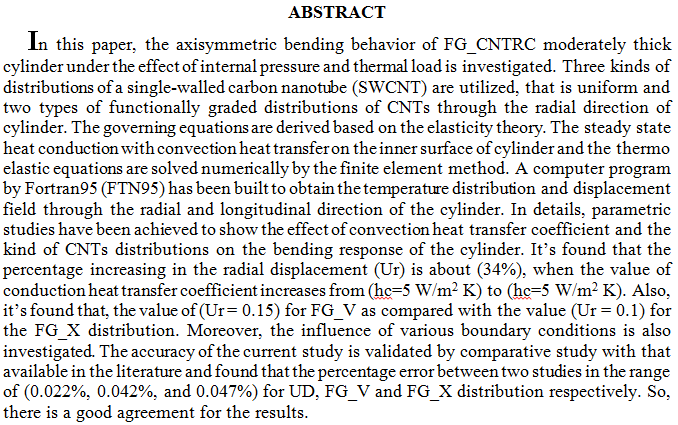
The aim of this investigation is to determine how different weight percentages of alumina nanoparticles, including 0.02, 0.04, and 0.06 percent wt, affect the physical characteristics of Poly Acrylamide (PAAM). Using a hot plate magnetic stirrer, 10 g of poly acrylamide powder was dissolved in 90 g of di-ionized distillate water for 4 hours to produce PAAM with a concentration of 0.11 g/ml. Four sections of the resulting solution, each with a volume of 20 ml, were created. Each solution was added independently with alumina nanoparticles in different ratios 0.0, 0.02, 0.04, and 0.06 to create four nano fluid solutions with different alumina nanoparticle contents based on each weight percent. The hand casting process for n
... Show More (4)
(4)
 (1)
(1)
In an attempt to disposal from nuclear waste which threats our health and environments. Therefore we have to find appropriate method to immobilize nuclear waste. So, in this research the nuclear waste (Strontium hydroxide) was immobilized by Carbon nanotubes (CNTs). The Nd-YAG laser with wave length 1064 nm, energy 750 mJ and 100 pulses used to prepare CNTs. After that adding Sr(HO)2 powder to the CNTs colloidal in calculated rate to get homogenous mixing of CNTs-Sr(OH)2. The Sr(HO)2 absorbs carbon dioxide from the air to form strontium carbonate so, the new solution is CNTs-SrCO3. To dry solution putting three drops from the new solution on the glass slides. To investigate the radi
... Show More (3)
(3)
 (3)
(3)
 (4)
(4)
Theoretical and experimental investigations have been carried out on developing laminar
combined free and forced convection heat transfer in a vertical concentric annulus with uniformly
heated outer cylinder (constant heat flux) and adiabatic inner cylinder for both aiding and opposing
flows. The theoretical investigation involved a mathematical modeling and numerical solution for
two dimensional, symmetric, simultaneously developing laminar air flows was achieved. The
governing equations of motion (continuity, momentum and energy) are solved by using implicit
finite difference method and the Gauss elimination technique. The theoretical work covers heat flux
range from (200 to 1500) W/m2, Re range from 400 to 2000 an
Abstract
In the present work the effect of bearing compliance on the performance of high speed misaligned journal bearing lined with a compliant PTFE liner lubricated with bubbly oil at high speeds has been studied. The effect of induced oil film temperature due to shearing effect has been implemented. Hydrodynamic effect of the complaint bearing and the influence of aerated oil have been examined by the classical thermohydrodynamic lubrication theory modified to include the effect of oil film turbulence and oil film temperature with suitable models for bubbly oil viscosity and density. The effect of liner elastic deformation has been implemented by using Winkler model. The effects of variable density and s
... Show MoreThe historical center's landscape suffers from neglect, despite their importance and broad capabilities in enhancing the cultural value of the historical center, as landscape includes many heterogeneous human and non-human components, material and immaterial, natural and manufactured, also different historical layers, ancient, modern and contemporary. Due to the difference in these components and layers, it has become difficult for the designer to deal with it. Therefore, the research was directed by following a methodology of actor-network theory as it deals with such a complex system and concerned with an advanced method to connect the various components of considering landscape as a ground that can include various elements and deal wi
... Show More (23)
(23)
The theoretical analysis depends on the Classical Laminated Plate Theory (CLPT) that is based on the Von-K ráman Theory and Kirchhov Hypothesis in the deflection analysis during elastic limit as well as the Hooke's laws of calculation the stresses. New function for boundary condition is used to solve the forth degree of differential equations which depends on variety sources of advanced engineering mathematics. The behavior of composite laminated plates, symmetric and anti-symmetric of cross-ply angle, under out-of-plane loads (uniform distributed loads) with two different boundary conditions are investigated to obtain the central deflection for mid-plane by using the Ritz method. The computer programs is built using Ma
... Show More (2)
(2)
The wear behavior of alumina particulate reinforced A332 aluminium alloy composites produced by a stir casting process technique were investigated. A pin-on-disc type apparatus was employed for determining the sliding wear rate in composite samples at different grain size (1 µm, 12µm, 50 nm) and different weight percentage (0.05-0.1-0.5-1) wt% of alumina respectively. Mechanical properties characterization which strongly depends on microstructure properties of reinforcement revealed that the presence of ( nano , micro) alumina particulates lead to simultaneous increase in hardness, ultimate tensile stress (UTS), wear resistances. The results revealed that UTS, Hardness, Wear resistances increases with the increase in the percentage of
... Show More